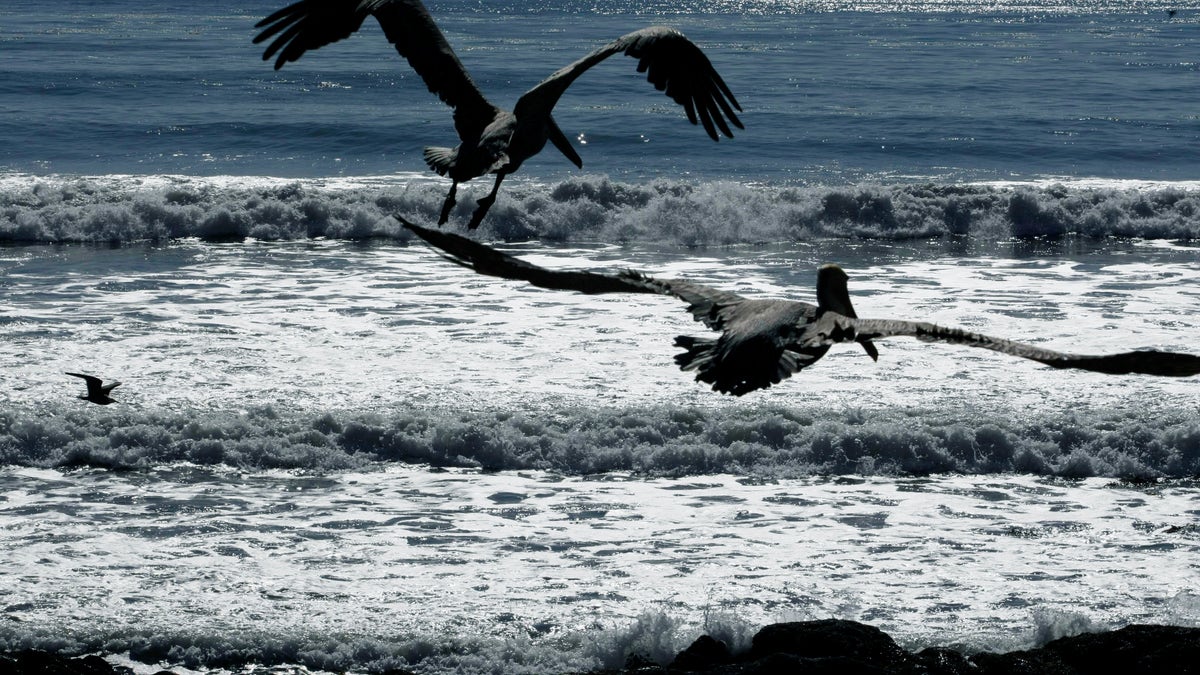
FILE - In this Feb. 10, 2010 file photo, California brown pelicans fly off after being released by the International Bird Rescue Research Center at the beach in San Pedro, Calif. Scientists and conservation groups are worried that the crash in West Coast sardine numbers that has forced cutbacks in commercial fishing is also hurting brown pelicans on the West Coast. The bird just came off the threatened species list four years ago. (AP Photo/Damian Dovarganes) (The Associated Press)
GRANTS PASS, Ore. – Scientists and conservation groups are worried the crash in West Coast sardines that has triggered deep cutbacks in commercial fishing is also starving brown pelicans that feed off California, Oregon and Washington.
Federal budget cuts have left scientists unable to do the research to figure out exactly what is going on. But the bits and pieces emerging don't look good.
"Prey availability for the pelican is definitely something we are concerned about, and we are making efforts to come up to speed ourselves along with other resource agencies," said Jeff Phillips, deputy assistant field supervisor for the U.S. Fish and Wildlife Service in Ventura, Calif. "We are really in the information gathering mode right now."
That frustrates Anna Weinstein, seabird program manager for the National Audubon Society in San Francisco.
"We don't think it is OK for the service to do a high five and walk away from the brown pelican just as it seems to be entering troubled waters," she said.
A formal status report required by the Endangered Species Act is due next year, but Phillips said it is not clear whether there will be money to do it. There are so many court-ordered efforts to determine whether endangered species listings are warranted, and so few resources since mandatory budget cuts kicked in, that work that is not under a court order, such as pelican monitoring, becomes a lower priority.
The California brown pelican was declared an endangered species in 1970 after its population was pushed to the brink of extinction by the pesticide DDT, which caused the bird's eggshells to become so thin that chicks could not hatch. After DDT was outlawed, the bird made a recovery and was taken off the list in 2009, when the West Coast population was 150,000.
Breeding has been good in Mexico's Gulf of California, which accounts for 90 percent of the West Coast birds, but no monitoring was done this year on the northernmost breeding colony in the Channel Islands off Southern California, said Dan Anderson, emeritus professor of wildlife biology at the University of California, Davis. Anecdotal reports suggest breeding was lousy.
"There is long-term data on pelican populations, but what's going on right now? Who knows? There is no systematic monitoring. It has been kind of a hit or miss thing," he said.
One hit comes from the 2013 Northwest survey by the Oregon Coast National Wildlife Refuge Complex. It found 7, 018 brown pelicans, half the average of the past decade, and the lowest number since 1999.
California brown pelicans eat mostly sardines and anchovies, which school near the surface, making them a perfect target for pelicans when they dive into the water and fill their beaks. Sardines are well known for cyclical population booms and busts. The most recent assessment for the Pacific Fishery Management Council put their overall biomass at 28 percent of a peak in 2006, leading to a decision to cut fishing harvests by two-thirds next year. Anchovies typically fill the gap when sardines crash, but it is not clear whether they are stepping up this time.
Sardines were declining in 2010 when wildlife rescue centers in California were filled with emaciated pelicans. The same year, young pelicans attacked murre nesting colonies in Oregon, shaking the chicks until they regurgitated fish, then eating the fish. They did it again in 2011 and 2012, said Robert Suryan, associate professor of wildlife at Oregon State University Hatfield Marine Science Center.
"Hundreds of murre chicks littered the shoreline," Suryan said. "It's a good example of what happens when you are hungry, and what you'll do to get food."

